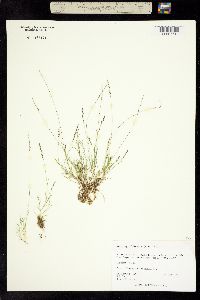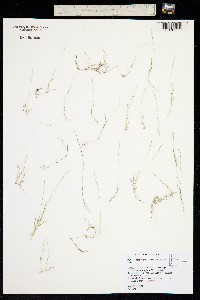Muhlenbergia filiformis
|
|
|
|
Family: Poaceae
Pullup Muhly, more...Pull-Up Muhly
[Muhlenbergia aristulata Rydb., moreMuhlenbergia filiformis var. fortis E.H. Kelso, Muhlenbergia idahoensis St. John, Muhlenbergia simplex (Scribn.) Rydb., Sporobolus aristatus , Sporobolus depauperatus var. filiformis Beal, Sporobolus filiformis (Thurb. ex S. Watson) Rydb., Sporobolus gracillimus (Thurb. ex S. Watson) Vasey, Sporobolus simplex var. thermale , Vilfa depauperata var. filiformis Thurb. ex S.Watson, Vilfa gracillima Thurb.] |
Plants annual (often appearing perennial), tufted. Culms (3)5-20(35) cm, erect or geniculate, often rooting at the lower nodes; internodes glabrous. Sheaths shorter or longer than the internodes, glabrous, smooth or scabridulous; ligules 1-3.5 mm, hyaline to membranous, rounded to acute; blades 1-4(6) cm long, 0.6-1.6 mm wide, flat or involute, smooth or scabridulous abaxially, scabrous or pubescent adaxially. Panicles 1.6-6 cm long, 0.2-0.5 cm wide, spikelike, interrupted near the base, long-exserted; primary branches 0.9-1.2 cm, closely appressed at maturity; pedicels 1-3 mm, scabrous. Spikelets 1.5-3.2 mm. Glumes greenish-gray, glabrous, 1-veined, rounded to subacute; lower glumes 0.6-1.4 mm; upper glumes 0.7-1.7 mm; lemmas (1.5)1.8-2.5(3.2) mm, lanceolate, dark greenish, appressed-pubescent on the margins and midveins, hairs shorter than 0.3 mm, apices scabridulous, acute to acuminate, unawned, sometimes mucronate, mucros shorter than 1 mm; paleas 1.6-2.6(3.1) mm, lanceolate, scabridulous distally; anthers 0.5-1.2 mm, purplish. Caryopses 0.9-1.5 mm, fusiform, reddish-brown. 2n = 18. Muhlenbergia filiformis grows in open, moist meadows, on gravelly lake shores, along stream banks, and in moist humus near thermal springs, at elevations of 1060-3050 m. It is usually associated with yellow pine forests, but also grows in many other plant communities. Its range extends into northern Mexico. Muhlenbergia filiformis resembles M. richardsonis, but differs in having glabrous internodes and subacute apices. Large, robust specimens have been referred to M. simplex Scribn. or M. filiformis var. fortis E.H. Kelso but, until there is more evidence to the contrary, it seems best to treat such plants as representing an extreme of the variation within M. filiformis. FNA 2003, Gould 1980 Common Name: pullup muhly Duration: Annual Nativity: Native Lifeform: Graminoid General: Slender annual, sometimes perennial; stem erect or lax and geniculate, 6-50 cm tall, smooth, rarely scaberulous below the nodes, branches at lower nodes, sheath open and smooth, mostly longer than internodes. Vegetative: Blades flat or margins loosely rolled upward, 1-6 cm long, 0.5-1.5 mm wide, rough-textured beneath, ligule thin and translucent, 1-3.5 mm long, rounded, edges can appear torn with age. Inflorescence: Panicle narrow, usually dark green, 2-8 cm long, 0.5-1 cm wide, can be densely flowered, lower inflorescence branches closely appressed, glumes subequal, 1-nerved, can be irregularly toothed and rough-textured near apex; 0.5-1.5 mm long, lemma 2-3.5 mm long, 3-nerved, rough-textured above, with small awn, palea equals lemma in length and similar texture, can be short appressed pubescent between the nerves. Ecology: Open bottoms and moist grassy meadows from 7,000-9,000 ft (2135-2740 m) flowers August-September. Notes: Low annual rooting at lower nodes, with rounded 1-3.5 mm long ligule, lower panicle branches appressed. This species has never been collected below the Mogollon Rim. Questionable- Ethnobotany: Used as fodder. Etymology: Muhlenbergia is named for Gotthilf Heinrich Ernst Muhlenberg (1753-1815) a clergyman and botanist from Pennsylvania; filiformis means thread-like. Synonyms: Muhlenbergia filiformis var. fortis, M. idahoensis, M. simplex Editor: SBuckley, 2010 |






























































































